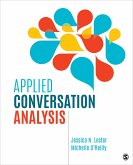- Broschiertes Buch
- Merkliste
- Auf die Merkliste
- Bewerten Bewerten
- Teilen
- Produkt teilen
- Produkterinnerung
- Produkterinnerung
This book describes a powerful method for analyzing communication in a variety of environments by studying how people adjust their behavior moment by moment during conversational exchanges.
Andere Kunden interessierten sich auch für
![Essentials of Qualitative Meta-Analysis Essentials of Qualitative Meta-Analysis]() Ladislav TimulakEssentials of Qualitative Meta-Analysis33,99 €
Ladislav TimulakEssentials of Qualitative Meta-Analysis33,99 €![Essentials of Discursive Psychology Essentials of Discursive Psychology]() Linda M. McMullenEssentials of Discursive Psychology39,99 €
Linda M. McMullenEssentials of Discursive Psychology39,99 €![Essentials of Existential Phenomenological Research Essentials of Existential Phenomenological Research]() Scott D. ChurchillEssentials of Existential Phenomenological Research33,99 €
Scott D. ChurchillEssentials of Existential Phenomenological Research33,99 €![Essentials of Thematic Analysis Essentials of Thematic Analysis]() Gareth TerryEssentials of Thematic Analysis33,99 €
Gareth TerryEssentials of Thematic Analysis33,99 €![Applied Conversation Analysis Applied Conversation Analysis]() Jessica Nina LesterApplied Conversation Analysis95,99 €
Jessica Nina LesterApplied Conversation Analysis95,99 €![Forms of Feeling Forms of Feeling]() Robert F. HobsonForms of Feeling55,99 €
Robert F. HobsonForms of Feeling55,99 €![Ethnomethodology, Conversation Analysis and Constructive Analysis Ethnomethodology, Conversation Analysis and Constructive Analysis]() Graham ButtonEthnomethodology, Conversation Analysis and Constructive Analysis191,99 €
Graham ButtonEthnomethodology, Conversation Analysis and Constructive Analysis191,99 €-
-
-
This book describes a powerful method for analyzing communication in a variety of environments by studying how people adjust their behavior moment by moment during conversational exchanges.
Produktdetails
- Produktdetails
- Essentials of Qualitative Methods Series
- Verlag: American Psychological Association
- Seitenzahl: 114
- Erscheinungstermin: 6. Juli 2021
- Englisch
- Abmessung: 224mm x 149mm x 9mm
- Gewicht: 184g
- ISBN-13: 9781433835667
- ISBN-10: 1433835665
- Artikelnr.: 60887435
- Essentials of Qualitative Methods Series
- Verlag: American Psychological Association
- Seitenzahl: 114
- Erscheinungstermin: 6. Juli 2021
- Englisch
- Abmessung: 224mm x 149mm x 9mm
- Gewicht: 184g
- ISBN-13: 9781433835667
- ISBN-10: 1433835665
- Artikelnr.: 60887435
Alexa Hepburn, PhD, is the Research Professor of Communication at Rutgers University. Dr. Hepburn's research focuses on the use and development of conversation analytic methods, including the notation and analysis of emotional expression within social interaction; the interactional role of interrogatives such as tag questions; parents' strategies for managing their children's behavior; and the empirical grounding of these interests in everyday interaction. Her work highlights limitations in more traditional perspectives on emotion and influence, and supports applied work in professional client encounters, including medical consultations and helpline interactions. Dr. Hepburn also continues to develop and deliver training workshops to various practitioners. Jonathan Potter, DPhil, is dean of the School of Communication and Information and Distinguished Professor of Communication at Rutgers University. Dr. Potter addresses fundamental issues of theory and method, and has made substantial research contributions in the area of language and racism, the operation of helplines, and the role of cognition in communication. His 1987 book, Discourse and Social Psychology: Beyond Attitudes and Behaviour, developed a new way of thinking about social psychology- highlighting the role of communication- and continues to be widely influential. His 1996 book on epistemics, Representing Reality: Discourse, Rhetoric and Social Construction has been heavily cited.
Series Foreword—Clara E. Hill and Sarah Knox
1. Conceptual Foundations of Conversation Analysis
Rationale
Historical and Theoretical Origins
Conversation Analysis and the Qualitative Tradition
The Philosophical and Epistemological Background to Conversation Analysis
How to Read This Book
Summary
2. Designing and Conducting Conversation Analysis
Gaining Access and Recruiting Participants
Data Collection
Research Team Considerations
Data Sessions
Adjusting for Biases and Expectations
Research Questions
Identifying Practices
Building Collections and Managing Data
Data Management
Summary
3. Transcribing for Conversation Analysis
Getting Started
Transcription Conventions
Speech Delivery and Intonation
Features Accompanying Talk
Transcribing Visible Conduct
Summary
4. Turn Taking, Sequence Organization, and Action Formation
Identifying and Applying the Tools of Conversation Analysis
Taking Turns in Conversation
Talking in Sequences
Summary of Sequence Organization
Action Formation
Epistemics
Tips for Applying the Tools in This Chapter
Summary
5. Storytelling, Repair, Preference Organization, and Person Reference
Narratives and Storytelling
Repair
Preference Organization
Person Reference
Integrating and Applying the Analytic Tools
Summary
6. Writing the Manuscript
Introduction
Method and Materials Section
Results or Analysis Section
Discussion and Conclusion Section
Tips for Applying the Tools in This Chapter
Summary
7. Methodological Integrity
Foundational Issues
Categorizing Conversation Analysis as a Method
Utility in Achieving Research Goals
Summary
8. Summary and Conclusions
Benefits
Limitations
Moving Forward With Conversation Analysis
Appendix: Exemplar Studies
References
Index
About the Authors
About the Series Editors
1. Conceptual Foundations of Conversation Analysis
Rationale
Historical and Theoretical Origins
Conversation Analysis and the Qualitative Tradition
The Philosophical and Epistemological Background to Conversation Analysis
How to Read This Book
Summary
2. Designing and Conducting Conversation Analysis
Gaining Access and Recruiting Participants
Data Collection
Research Team Considerations
Data Sessions
Adjusting for Biases and Expectations
Research Questions
Identifying Practices
Building Collections and Managing Data
Data Management
Summary
3. Transcribing for Conversation Analysis
Getting Started
Transcription Conventions
Speech Delivery and Intonation
Features Accompanying Talk
Transcribing Visible Conduct
Summary
4. Turn Taking, Sequence Organization, and Action Formation
Identifying and Applying the Tools of Conversation Analysis
Taking Turns in Conversation
Talking in Sequences
Summary of Sequence Organization
Action Formation
Epistemics
Tips for Applying the Tools in This Chapter
Summary
5. Storytelling, Repair, Preference Organization, and Person Reference
Narratives and Storytelling
Repair
Preference Organization
Person Reference
Integrating and Applying the Analytic Tools
Summary
6. Writing the Manuscript
Introduction
Method and Materials Section
Results or Analysis Section
Discussion and Conclusion Section
Tips for Applying the Tools in This Chapter
Summary
7. Methodological Integrity
Foundational Issues
Categorizing Conversation Analysis as a Method
Utility in Achieving Research Goals
Summary
8. Summary and Conclusions
Benefits
Limitations
Moving Forward With Conversation Analysis
Appendix: Exemplar Studies
References
Index
About the Authors
About the Series Editors
Series Foreword—Clara E. Hill and Sarah Knox
1. Conceptual Foundations of Conversation Analysis
Rationale
Historical and Theoretical Origins
Conversation Analysis and the Qualitative Tradition
The Philosophical and Epistemological Background to Conversation Analysis
How to Read This Book
Summary
2. Designing and Conducting Conversation Analysis
Gaining Access and Recruiting Participants
Data Collection
Research Team Considerations
Data Sessions
Adjusting for Biases and Expectations
Research Questions
Identifying Practices
Building Collections and Managing Data
Data Management
Summary
3. Transcribing for Conversation Analysis
Getting Started
Transcription Conventions
Speech Delivery and Intonation
Features Accompanying Talk
Transcribing Visible Conduct
Summary
4. Turn Taking, Sequence Organization, and Action Formation
Identifying and Applying the Tools of Conversation Analysis
Taking Turns in Conversation
Talking in Sequences
Summary of Sequence Organization
Action Formation
Epistemics
Tips for Applying the Tools in This Chapter
Summary
5. Storytelling, Repair, Preference Organization, and Person Reference
Narratives and Storytelling
Repair
Preference Organization
Person Reference
Integrating and Applying the Analytic Tools
Summary
6. Writing the Manuscript
Introduction
Method and Materials Section
Results or Analysis Section
Discussion and Conclusion Section
Tips for Applying the Tools in This Chapter
Summary
7. Methodological Integrity
Foundational Issues
Categorizing Conversation Analysis as a Method
Utility in Achieving Research Goals
Summary
8. Summary and Conclusions
Benefits
Limitations
Moving Forward With Conversation Analysis
Appendix: Exemplar Studies
References
Index
About the Authors
About the Series Editors
1. Conceptual Foundations of Conversation Analysis
Rationale
Historical and Theoretical Origins
Conversation Analysis and the Qualitative Tradition
The Philosophical and Epistemological Background to Conversation Analysis
How to Read This Book
Summary
2. Designing and Conducting Conversation Analysis
Gaining Access and Recruiting Participants
Data Collection
Research Team Considerations
Data Sessions
Adjusting for Biases and Expectations
Research Questions
Identifying Practices
Building Collections and Managing Data
Data Management
Summary
3. Transcribing for Conversation Analysis
Getting Started
Transcription Conventions
Speech Delivery and Intonation
Features Accompanying Talk
Transcribing Visible Conduct
Summary
4. Turn Taking, Sequence Organization, and Action Formation
Identifying and Applying the Tools of Conversation Analysis
Taking Turns in Conversation
Talking in Sequences
Summary of Sequence Organization
Action Formation
Epistemics
Tips for Applying the Tools in This Chapter
Summary
5. Storytelling, Repair, Preference Organization, and Person Reference
Narratives and Storytelling
Repair
Preference Organization
Person Reference
Integrating and Applying the Analytic Tools
Summary
6. Writing the Manuscript
Introduction
Method and Materials Section
Results or Analysis Section
Discussion and Conclusion Section
Tips for Applying the Tools in This Chapter
Summary
7. Methodological Integrity
Foundational Issues
Categorizing Conversation Analysis as a Method
Utility in Achieving Research Goals
Summary
8. Summary and Conclusions
Benefits
Limitations
Moving Forward With Conversation Analysis
Appendix: Exemplar Studies
References
Index
About the Authors
About the Series Editors







